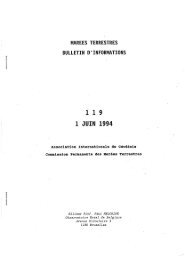marees terrestres bulletin d'informations - Université de la Polynésie ...
marees terrestres bulletin d'informations - Université de la Polynésie ...
marees terrestres bulletin d'informations - Université de la Polynésie ...
You also want an ePaper? Increase the reach of your titles
YUMPU automatically turns print PDFs into web optimized ePapers that Google loves.
Table 6: Variation of cross corre<strong>la</strong>tion coefficient between residual gravity and un<strong>de</strong>rground water<br />
level fluctuation, Lake Nasser area, Aswan, Egypt.<br />
Period<br />
Corre<strong>la</strong>tion<br />
coefficient<br />
From Mar., 2003 to Dec., 2004 +0.480<br />
ground water level<br />
fluctuations (cm)<br />
From Mar., 2003 to Jun., 2003 +0.352 10<br />
From Jul., 2003 to Sep., 2003 +0.283 7<br />
From Oct., 2003 to Dec., 2003 +0.336 8<br />
6. Time Variation of the Earth's Gravity Field at Lake Nasser Area<br />
Zhang et al. (1996) <strong>de</strong>veloped a method to predict time variations of the Earth's gravity field and<br />
crustal <strong>de</strong>formation due to mass loading caused by the impounding of the three Gorges reservoir.<br />
Zahran (2005, pers. communication) used Zhang's method to compute the effect of the induce<br />
loading on the gravity field during the period of study. Fig. 8 shows gravity field variations as<br />
induced by water level variations at Lake Nasser. It can be seen that the variation in gravity follows<br />
the variation of the water level in the <strong>la</strong>ke. The maximum gravity variation is 500 nm /s 2 due to<br />
maximum water level variation. The range of induced load gravity variation is significant for tidal<br />
observations and also for repeated gravity variations for geo<strong>de</strong>tic purposes. The high residuals were<br />
found to be associated with high water level variations. Moreover, the obtained phase shift between<br />
water level variation and residual gravity (Fig. 4) is not clear. This effect may be due to mass<br />
changes by water migrating through the rock around the <strong>la</strong>ke in addition to the e<strong>la</strong>stic behaviour.<br />
7. Discussion<br />
A combined plot of water level variation and residual gravity shows that the residual gravity<br />
follows water level variation with a time <strong>de</strong><strong>la</strong>y. This time shift may be due to the permeability of<br />
the rocks and migrating water masses. On the other hand, the differences of the tidal parameters in<br />
different blocks un<strong>de</strong>r different loading conditions may be due to pore pressure changes, and, thus,<br />
modifications of overall e<strong>la</strong>sticity of the rock. There is a mo<strong>de</strong>rate corre<strong>la</strong>tion between residual<br />
gravity variation and <strong>la</strong>ke water level variation, whereas the corre<strong>la</strong>tion between residual gravity<br />
and un<strong>de</strong>rground water variation is weak. Corre<strong>la</strong>tion coefficients of selected blocks show that their<br />
values follow to a great extent the values of water level variations on one si<strong>de</strong> and on the other si<strong>de</strong><br />
groundwater variation. The effect of induced load in the <strong>la</strong>ke on the gravity field was calcu<strong>la</strong>ted at<br />
different water levels at Aswan tidal gravity station. The range of induced load gravity variation is<br />
significant for tidal observations and also for repeated gravity surveys for geo<strong>de</strong>tic purposes.<br />
11815



